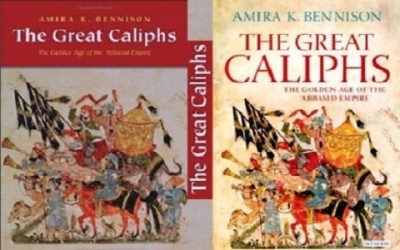The Abbasid era is one of the basic phases of Iranian medieval history. The Abbasid caliphs developed an advanced and civilized state by drawing on the Umayyad, the Sassanian, and the Byzantine states. “The Great Caliphs, The Golden Age of the Abbasid Empire” by Amira K. Bennison[1] is one of the remarkable works about the golden age of economic and cultural achievement in the Abbasid Caliphate (750-1258).
This book consists of an introduction and 6 chapters: 1. A Stormy Sea: The Politics of the Abbasid Caliphate, 2. From Baghdad to Córdoba: The Cities of Classical Islam, 3. Princes and Beggars: Life and Society in the Abbasid Age, 4. The Lifeblood of Empire: Trade and Traders in the Abbasid Age, 5. “Baghdad’s Golden Age: Islam’s Scientific Renaissance and 6. The Abbasid Legacy. As the titles of the chapters show, the content of the book is fundamentally social history. Based on a wide range of sources, it offers a new understanding of the civilization of the Abbasid Empire. Having reviewed the political context, the book moves on to discuss the Islamic society's economy, science, laws, and conventions alongside the realities of social life.
The first chapter, A Stormy Sea: “The Politics of the Abbasid Caliphate” outlines political history from the earliest days of Islam up to the time of the Crusades. It was really the Abbasid caliphate from 750 to around 900 that forms the core of this lively and entertaining work.
The second chapter “From Baghdad to Córdoba: The Cities of Classical Islam” emphasizes the vitality and variety of urban centers. It is one of the strengths of this book that the author gives full weight to the achievements of the western areas of the Muslim world, the Maghreb and al-Andalus: Córdoba, as well as Baghdad, gets its fair share of attention.
In the next three chapters “Princes and Beggars: Life and Society in the Abbasid Age”, “The Lifeblood of Empire: Trade and Traders in the Abbasid Age”, and “Baghdad’s ‘Golden Age: Islam’s Scientific Renaissance”, Bennison moves on to inhabitants, and they are all here, from rulers and their courts, their poets and their eunuchs to the beggars and prostitutes of the meaner streets and the peasants and nomads of the countryside, so often forgotten in general accounts of the Muslim world. Muhammad himself was a merchant. Merchants always had a higher social status in the Muslim sphere than was the case in Christendom, and Bennison describes the wealth and ramifications of merchants’ activity.
Amira Bennison shows well how central urban life was to the Abbasid Empire – from Iberia to India, with Baghdad at its heart – and with it all that cities can offer: conversation, books, schools, performance, poetry, and sumptuous goods. Scholars and rulers recognized that Baghdad could harness the powers of east and west, the sciences of Europe, the Mediterranean, the Near East, and Asia. To do so was to allow a public sphere to develop, one that did not threaten the ultimate truth of Islam and its caliphs-protectors, but which allowed the traditions of the empire’s people to converge and cross-fertilize. Patronage for translation meant that classical science was disseminated and preserved – often by Syriac Christians and Jews – and that medicine and astronomy, mathematics, and metallurgy benefited from frequent mutual encounters. The grandeur of the empire also meant that projects of poor relief, the building of mosques and palaces, provision of water supplies, and public hygiene were conceived. These projects were conceived to beautify and make more life comfortable in the vast cities.[2]
In the final chapter “The ‘Abbasid Legacy”, Bennison turns to intellectual life and here she stresses the vast variety of cultural practices, from the study of the Qur’an and the traditions of the Prophet, which form the foundations of Islamic law, the Sharia, to the movement to translate works of Greek science and medicine (though not of history or poetry) into Arabic.
Bennison has a lively and engaging style and a way of using short extracts from original Arabic sources to bring particular features – the ruler’s audience or the market supervisor’s policing duties – to life.[3] She proposes a hypothesis that far from seeing themselves as purging the ‘occidental culture of the ancient world with a ‘pure’ and oriental’ Islamic doctrine, the Abbasids perceived themselves to be as much within the tradition of Mediterranean and Near Eastern empire as any of their predecessors.[4]
Hence, one of the critical themes she follows is the connection between Islamic and European civilizations. She concludes that “the Renaissance was a European phenomenon, but such a rebirth of classical knowledge depended in part on its preservation and elaboration by Arabic speakers in Islamic lands. For European intellectuals of the twelfth to sixteenth centuries, this was not really a contentious point: many scholars and scientists of the Arabo-Islamic world were household names in university circles, and Arabic was one of the languages all MA students at Oxford had to study in the seventeenth century. It is only in modern times that we have forgotten this connection. However, in reality, we are all part of the story of human civilization which began in the Middle East in the sixth millennium BCE and all those who insist upon the irreconcilable division between the ‘West’ and ‘Islam’ would do well to step down from their soapboxes and read a bit of history” (Bennison, 2009, 214).
Maryam Kamali
Bennison, Amira, K. (2009). The Great Caliphs, the Golden Age of the Abbasid Empire, Yale University Press: IB.Tauris.

